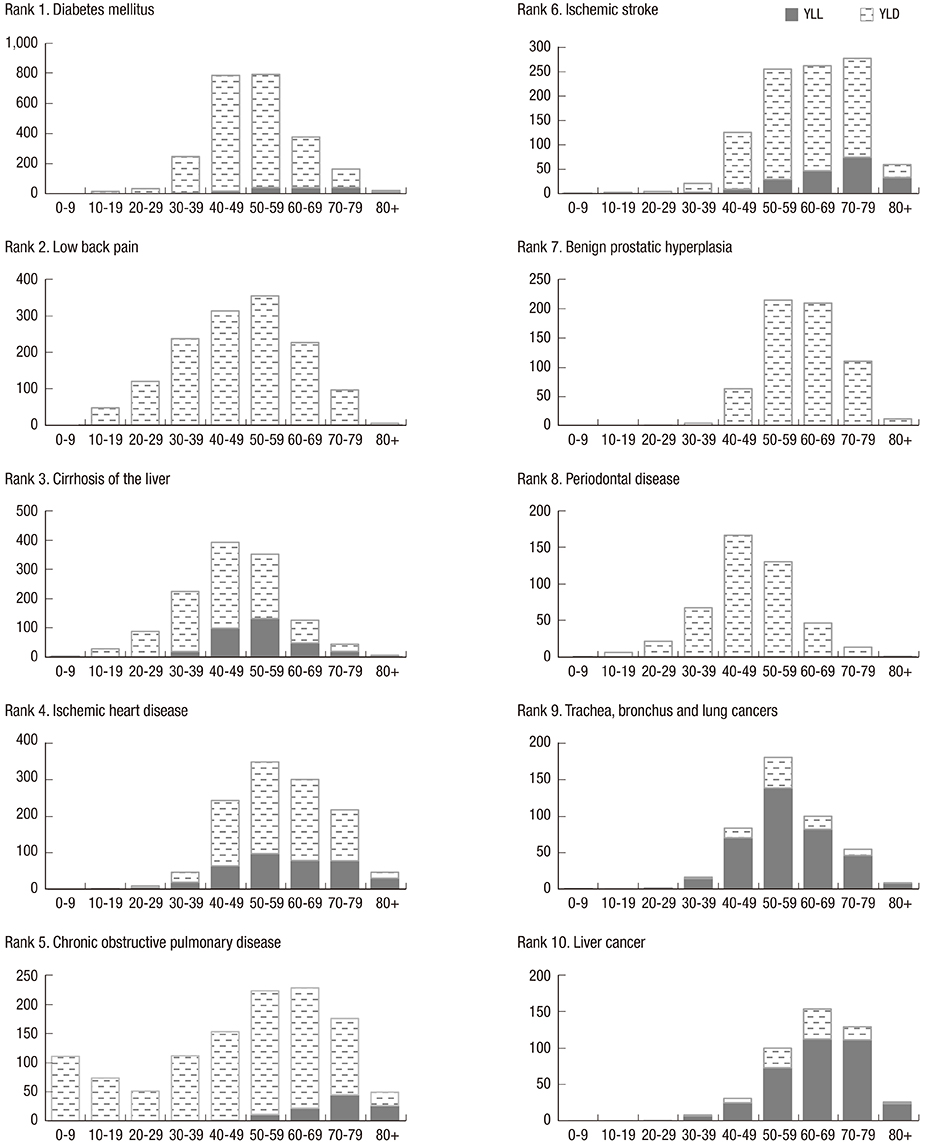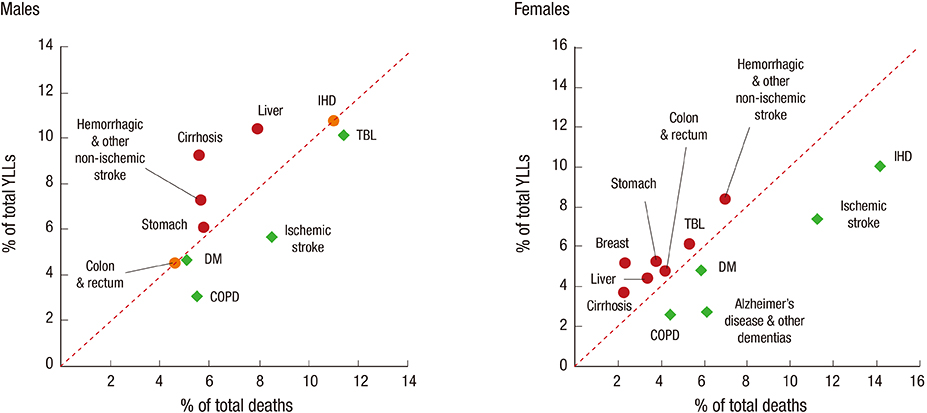The Non-Communicable Disease Burden in Korea: Findings from the 2012 Korean Burden of Disease Study
- Affiliations
-
- 1Department of Public Health, Graduate School, Korea University, Seoul, Korea.
- 2Department of Preventive Medicine, School of Medicine, Kyung Hee University, Seoul, Korea.
- 3Department of Preventive Medicine, College of Medicine, Korea University, Seoul, Korea. yoonsj02@korea.ac.kr
- KMID: 2360666
- DOI: http://doi.org/10.3346/jkms.2016.31.S2.S158
Abstract
- In recognition of Korea's rising burden of non-communicable diseases (NCDs), we investigated the nation's NCD status and extracted detailed information from the 2012 Korean Burden of Disease study. Consistent with that study, we used disability-adjusted life year (DALY) as a metric. Using national data sources and disability weights specific to the Korean population, we analyzed 116 disaggregated NCDs from the study's four-level disease and injury hierarchy for both sexes and nine age groups. Per 100,000 population, 21,019 DALYs were lost to 116 NCDs. Of those, 13.97% were due to premature death (death prior to the standard life expectancy for a subject's age) and 86.03% to non-fatal health outcomes. Based on traditional statistics, the main causes of health loss were mortality of neoplasms; cardiovascular and circulatory diseases; diabetes, urogenital, blood, and endocrine diseases; and chronic respiratory diseases. When combined with analyses of premature death and non-fatal outcomes, however, a substantially different view emerged: the main causes of health loss were diabetes mellitus, low back pain, chronic obstructive pulmonary disease, ischemic heart disease, ischemic stroke, cirrhosis of the liver, osteoarthritis, asthma, gastritis and duodenitis, and periodontal disease (in that order), collectively causing 49.20% of DALYs. Thus, burden of disease data using DALYs rather than traditional statistics brings a new perspective to characterization of the population's health that provides practical information useful for developing and targeting national NCD control programs to better meet national needs.
MeSH Terms
Figure
Cited by 5 articles
-
Chasms in Achievement of Recommended Diabetes Care among Geographic Regions in Korea
Sanghyun Cho, Ji-Yeon Shin, Hyun Joo Kim, Sang Jun Eun, Sungchan Kang, Won Mo Jang, Hyemin Jung, Yoon Kim, Jin Yong Lee
J Korean Med Sci. 2019;34(31):. doi: 10.3346/jkms.2019.34.e190.Revised (2018) COPD Clinical Practice Guideline of the Korean Academy of Tuberculosis and Respiratory Disease: A Summary
Yong-Bum Park, Chin Kook Rhee, Hyoung Kyu Yoon, Yeon-Mok Oh, Seong Yong Lim, Jin Hwa Lee, Kwang-Ha Yoo, Joong Hyun Ahn,
Tuberc Respir Dis. 2018;81(4):261-273. doi: 10.4046/trd.2018.0029.Prevalence and socioeconomic burden of chronic obstructive pulmonary disease
Tai Joon An, Hyoung Kyu Yoon
J Korean Med Assoc. 2018;61(9):533-538. doi: 10.5124/jkma.2018.61.9.533.Diabetes Fact Sheet in Korea, 2016: An Appraisal of Current Status
Jong Chul Won, Jae Hyuk Lee, Jae Hyeon Kim, Eun Seok Kang, Kyu Chang Won, Dae Jung Kim, Moon-Kyu Lee
Diabetes Metab J. 2018;42(5):415-424. doi: 10.4093/dmj.2018.0017.Korean National Burden of Disease: The Importance of Diabetes Management
Chung-Nyun Kim, Yoon-Sun Jung, Young-Eun Kim, Minsu Ock, Seok-Jun Yoon
Diabetes Metab J. 2024;48(4):518-530. doi: 10.4093/dmj.2024.0087.
Reference
-
1. Korea Centers for Disease Control and Prevention. Factbook: Non-communicable Diseases 2015. Cheongju: Korea Centers for Disease Control and Prevention;2015.2. Statistics Korea. Trends in life expectancy and healthy life expectancy [Internet]. accessed on 3 January 2015. Available at http://www.index.go.kr/potal/main/EachDtlPageDetail.do?idx_cd=2758.3. Ko SJ, Jung YH. Health-adjusted life expectancy in Korea. Issue Focus. 2014; 247:1–8.4. Murray CJ, Salomon JA, Mathers CD, Lopez AD. Summary Measures of Population Health: Concepts, Ethics, Measurement and Applications. Geneva: World Health Organization;2002.5. Van der Maas PJ. Applications of summary measures of population health. In : Murray CJ, Salomon JA, Mathers CD, Lopez AD, editors. Summary Measures of Population Health: Concepts, Ethics, Measurement and Applications. Geneva: World Health Organization;2002. p. 53–60.6. Pinheiro P, Plaß D, Krämer A. The burden of disease approach for measuring population health. In : Krämer A, Khan MH, Kraas F, editors. Health in Megacities and Urban Areas. Heidelberg: Springer;2011. p. 21–38.7. Lopez AD, Mathers CD, Ezzati M, Jamison DT, Murray CJ. Measuring the global burden of disease and risk factors, 1990??001. In : Lopez AD, Mathers CD, Ezzati M, Jamison DT, Murray CJ, editors. Global Burden of Diseases and Risk Factors. . Washington, D.C.: The World Bank;2006. p. 1–14.8. Murray CJ, Lopez AD. The Global Burden of Disease: a Comprehensive Assessment of Mortality and Disability from Diseases, Injuries and Risk Factors in 1990 and Projected to 2020. Boston, MA: Harvard University Press;1996.9. Mathers CD, Vos T, Lopez A, Salomon J, Ezzati M. National Burden of Disease Studies: a Practical Guide. Geneva: World Health Organization;2001.10. Yoon J, Oh IH, Seo H, Kim EJ, Gong YH, Ock M, Lim D, Lee WK, Lee YR, Kim D, et al. Disability-adjusted Life Years for 313 Diseases and Injuries: the 2012 Korean Burden of Disease Study. J Korean Med Sci. 2016; 31:Suppl 2. S146–S157.11. Lim D, Lee WK, Park H. Disability-adjusted Life Years (DALYs) for Mental and Substance Use Disorders in the Korean Burden of Disease Study 2012. J Korean Med Sci. 2016; 31:Suppl 2. S191–S199.12. World Health Organization. Metrics: disability-adjusted life year (DALY) [Internet]. accessed on 30 November 2015. Available at http://www.who.int/healthinfo/global_burden_disease/metrics_daly/en/.13. Korean Statistical Information Service. Life table [Internet]. accessed on 17 November 2015. Available at http://kosis.kr/statisticsList/statisticsList_01List.jsp?vwcd=MT_ZTITLE&parentId=A#SubCont.14. Lee YR, Kim YA, Park SY, Oh CM, Kim YE, Oh IH. Application of a Modified Garbage Code Algorithm to Estimate Cause-Specific Mortality and Years of Life Lost in Korea. J Korean Med Sci. 2016; 31:Suppl 2. S121–S128.15. Barendregt JJ, Van Oortmarssen GJ, Vos T, Murray CJ. A generic model for the assessment of disease epidemiology: the computational basis of DisMod II. Popul Health Metr. 2003; 1:4.16. Ock M, Lee JY, Oh IH, Park H, Yoon SJ, Jo MW. Disability Weights Measurement for 228 Causes of Disease in the Korean Burden of Disease Study 2012. J Korean Med Sci. 2016; 31:Suppl 2. S129–S138.17. Alwan A. Global Status Report: on Noncommunicable Diseases 2010. Geneva: World Health Organization;2011.18. Mathers C, Boerma T, Fat DM. The Global Burden of Disease: 2004 Update. Geneva: World Health Organization;2008.19. Murray CJ, Lopez AD. Measuring the global burden of disease. N Engl J Med. 2013; 369:448–457.20. Murray CJ, Vos T, Lozano R, Naghavi M, Flaxman AD, Michaud C, Ezzati M, Shibuya K, Salomon JA, Abdalla S, et al. Disability-adjusted life years (DALYs) for 291 diseases and injuries in 21 regions, 1990-2010: a systematic analysis for the global burden of disease study 2010. Lancet. 2012; 380:2197–2223.21. Hoy D, March L, Brooks P, Blyth F, Woolf A, Bain C, Williams G, Smith E, Vos T, Barendregt J, et al. The global burden of low back pain: estimates from the global burden of disease 2010 study. Ann Rheum Dis. 2014; 73:968–974.22. Hoy DG, Smith E, Cross M, Sanchez-Riera L, Buchbinder R, Blyth FM, Brooks P, Woolf AD, Osborne RH, Fransen M, et al. The global burden of musculoskeletal conditions for 2010: an overview of methods. Ann Rheum Dis. 2014; 73:982–989.23. March L, Smith EU, Hoy DG, Cross MJ, Sanchez-Riera L, Blyth F, Buchbinder R, Vos T, Woolf AD. Burden of disability due to musculoskeletal (MSK) disorders. Best Pract Res Clin Rheumatol. 2014; 28:353–366.24. Vos T, Barber RM, Bell B, Bertozzi-Villa A, Biryukov S, Bolliger I, Charlson F, Davis A, Degenhardt L, Dicker D. Global, regional, and national incidence, prevalence, and years lived with disability for 301 acute and chronic diseases and injuries in 188 countries, 1990-2013: a systematic analysis for the global burden of disease study 2013. Lancet. 2015; 386:743–800.25. Hoy D, Geere JA, Davatchi F, Meggitt B, Barrero LH. A time for action: opportunities for preventing the growing burden and disability from musculoskeletal conditions in low- and middle-income countries. Best Pract Res Clin Rheumatol. 2014; 28:377–393.26. Yoon SJ, Bae SC, Lee SI, Chang H, Jo HS, Sung JH, Park JH, Lee JY, Shin Y. Measuring the burden of disease in Korea. J Korean Med Sci. 2007; 22:518–523.27. Kim EJ, Yoon SJ, Jo MW, Kim HJ. Measuring the burden of chronic diseases in Korea in 2007. Public Health. 2013; 127:806–813.28. Korean Diabetes Association; National Heatlh Insurance Service (KR). Korean Diabetes Fact Sheet: 2015. Seoul: Korean Diabetes Association;2015.29. Kwon HS, Kim WH, Lee DY, Park SI. Current status and need for a Korean diabetes prevention study. Public Health Wkly Rep. 1995; 8:746–753.30. World Health Organization. Noncommunicable Diseases Progress Monitor 2015. Geneva: World Health Organization;2015.31. World Health Organization. Preventing Chronic Diseases: a Vital Investment. Geneva: World Health Organization;2005.32. Beaglehole R, Bonita R, Horton R, Adams C, Alleyne G, Asaria P, Baugh V, Bekedam H, Billo N, Casswell S, et al. Priority actions for the non-communicable disease crisis. Lancet. 2011; 377:1438–1447.33. Alleyne G, Binagwaho A, Haines A, Jahan S, Nugent R, Rojhani A, Stuckler D; Lancet NCD Action Group. Embedding non-communicable diseases in the post-2015 development agenda. Lancet. 2013; 381:566–574.34. Bonita R, Magnusson R, Bovet P, Zhao D, Malta DC, Geneau R, Suh I, Thankappan KR, McKee M, Hospedales J, et al. Country actions to meet UN commitments on non-communicable diseases: a stepwise approach. Lancet. 2013; 381:575–584.35. World Health Organization. Global Action Plan: for the Prevention and Control of Noncommunicable Diseases 2013-2020. Geneva: World Health Organization;2013.36. Ezzati M, Riboli E. Can noncommunicable diseases be prevented? Lessons from studies of populations and individuals. Science. 2012; 337:1482–1487.
- Full Text Links
- Actions
-
Cited
- CITED
-
- Close
- Share
- Similar articles
-
- Overview of the Burden of Diseases in North Korea
- Health Performance and Challenges in Korea: a Review of the Global Burden of Disease Study 2013
- The burden of disease in Korea
- Korean National Burden of Disease: The Importance of Diabetes Management
- Comparative Research for the Healthcare Budget and Burden of Disease in Perspective Resource Allocation






